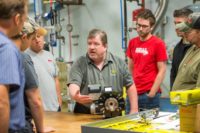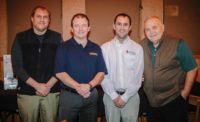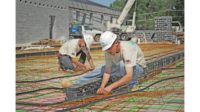You know what John Barba, The NEWS’ 2015 Best Trainer, was doing the night before he held a hydronics seminar in Allentown, Pennsylvania, earlier this year?
He was attending the last steam heat seminar by the godfather of wet-head artisanship, Dan Holohan, in New York.
“We’re all students,” offered Barba, eagerly. “And, when Dan announced he’d conduct one last steam-heat training session before his retirement, a bunch of us from Taco [where Barba serves as a hydronics trainer] hopped on a train to catch it. I wouldn’t have missed it for the world, and what a finale it was.
“Dan is the trainer of trainers; we are merely his disciples,” added Barba. “His reign as an amazingly talented, and very amusing, trainer — and one who has given so many of us an entirely new outlook about how we can hone our skills and apply them — has been nothing short of epic. So few industries have had a flag bearer and humorist such as Holohan — just look at how he gave so much of himself to so many.”
And so it is that some of the hydronics industry’s great teachers tie their inspiration and skills to those before them and those they admire.
In keeping with that tradition, Anthony Reikow, hydronics trainer for Bensalem, Pennsylvania-based manufacturer’s rep firm, B.J. Terroni Co. Inc., a lively and successful hydronics trainer who hosted John Barba’s appearance at the Allentown BrewWorks, introduced Barba by saying, “John Barba is the very reason I stand before you today.”
“When I attended a John Barba seminar at Wirsbo [now Uponor] about 15 years ago, I couldn’t believe that someone could have that much fun and get that much exercise while speaking to a bunch of hydronics installers,” added Reikow.
“No, really,” he added, just to be sure his audience bought the explanation. “This guy taught me that you should go off the charts to reach others, deliver a message, drive it home, make it memorable, and, hey, have some fun while doing it. So, folks, without further ado, here’s the real deal: Let me introduce the guy who taught me it’s OK to laugh at yourself and have a load of fun while teaching others about the fine art of hydronics.”
A GROWING SECTOR
The hydronics industry is gaining a strong foothold in the American share of mind. Take a moment to consider this: It wasn’t that long ago that forced-air systems almost fully supplanted hydronics because of its ability to heat and cool.
Ah, but our utilitarian perspective, brains, and bodies have restlessly looked for more. Forced air has come a long way, too, since those early days.
Though hydronics still holds sway with a determined set of old-schoolers unwilling to set their soldering torches (or ProPress tools) aside, the discipline has gained a lot of appreciation among the younger set because of its ability to provide comfort without compromise, enhanced IAQ, controllability, integration with all other HVAC disciplines (yes, even forced-air systems), and for the raw simplicity and predictability of it.
As Dan Holohan loves to say when he moves to the most elemental message, “Be the water.”
It’s pure Zen simplicity.
“Imagine you are that molecule, that droplet, that steam, that flow of moving warmth channeled and piped to its destination and purpose. Where will it go? What will it do? How will it act? What have you done, or can you do, to facilitate its easiest purpose?”
So, it was Holohan who was channeled on this day in
Allentown.
With heads bobbing in agreement and understanding, Barba jumped right in with clarity, painting a picture of hydronics and how best to accomplish the purpose of proper heat transfer and system flow while stirring conversation, interaction, and laughter.
Barba led a lively discussion about circulators, those rather important hydronic components, and how they influence the entire system and affect system efficiency.
“When homeowners — and no small number of installers — think of efficiency as so often they focus solely on the boiler,” said Barba. “That’s understandable. After all, it’s the largest component.”
Attendees learned from Barba that, in Germany, a country that arguably is the heart of European hydronics, is now strictly enforced by efficiency standards.
Then, summoning the very spirit of Holohan — who Barba attributes this information to — Barba’s voice suddenly grows in volume, and with a convincing accent, he blurts out: “Do you know what ze German chimney sweeps do today? Zey don’t just sweep ze chimneys, zey enforce ze law.”
He bangs on a table loudly, three forceful raps, and waits. Then three more — louder, as glasses splash water and students reach for pens that have fallen to the floor.
“This is ze chimney sweep, Gestapo! We have come to inspect yer boiler. Open ze door immediately!”
Barba then explains to the laughing, wide-eyed group that if the thorough boiler inspection, which does include a cleaning of the chimney or flue passage, does not go well — especially if the boiler cannot meet the country’s stringent efficiency standards — the chimney sweeps are authorized to cut it out and remove it.
“Can you imagine something like that happening here, in Pennsylvania?” he asked, with emphasis.
“In this state, you have Philadelphia in the East, Pittsburgh in the West, and Alabama in between. Why, ole Gestapo would jump for the double-barrel 12 gauge and swing it to eye level at any chimney sweep dumb enough to attempt such a thing in no time at all. End of discussion. Nope, not here.
“The concept of system efficiency is certainly gaining share of mind here in the U.S., but not with that sort of conviction,” he added.
Which, after more tumultuous laughter from the crowd, brought the conversation back to system efficiency and the influence of hydronics components.
Barba talked about the advantages and disadvantages of managing flow with circulators or zone valves, focusing on how they differ, and how each offers a unique function.
“Using a high-head pump when a low-head pump is needed will work, meaning it will deliver heat,” asserted Barba. “The problem is that even though the space is heated, zone valves may bang. This is due to the fact they’re closing against a much higher pressure differential with a high head, steep curve pump, and a much lower pressure differential when closing against a lower-head, higher-flow, flat-curve pump.
“That’s the problem.” Barba said, leaping skyward to make the point.
He explained: Zone valves don’t like to do that and so they make a ruckus. Too often, installers only look at a problem as no heat. In this case, the noise is the problem.
Barba points out there’s a difference between knowledge and understanding.
“Technical knowledge of hydronic components is great, but, without understanding what they do, once you take them out of the box and actually install them into a system with their own particular dynamics, you can shortchange both yourself and your customers” he said.
“No one sets out to install a system that isn’t as efficient or as comfortable as it should be,” continued Barba. “We all want to do the best job possible.”
According to Barba, anyone can buy a bunch of high-quality components, stick them together, keep the water on the inside, and call it a hydronic heating system. It’s not that difficult. The real skill of an exceptional professional lies in understanding what these different components do and then picking the ones that will work together best for each individual system.
“Maximize overall system efficiency and performance instead of limiting overall system efficiency and performance,” he said. “Hydronics can be exceptional, but not without you.”
Asked what he thought after the group dispersed later that evening, Reikow said, “Most folks are looking at the boiler efficiency only and there needs to be a good, long look at the system efficiency.”
“Understanding what is happening with system flow and how it relates to the boiler efficiency and output is so very important,” he added. “Barba spells this out for installers, and, along the way, they also learn about Taco’s new ECM [electronically commutated motor] circulators and how they help to create —
from a boiler-driven hydronics system — Philharmonic Symphony-like performance.”
If Holohan can teach the Zen of hydronics, Barba and Reikow are encouraging symphonic perfection.
Publication date: 5/30/2016
Want more HVAC industry news and information? Join The NEWS on Facebook, Twitter, and LinkedIn today!






Report Abusive Comment